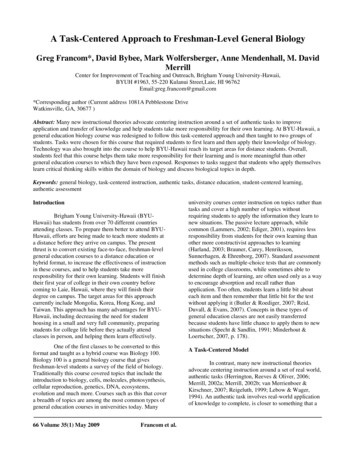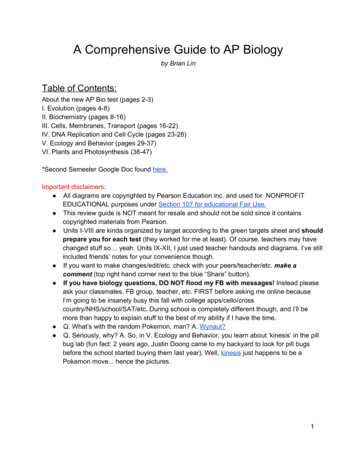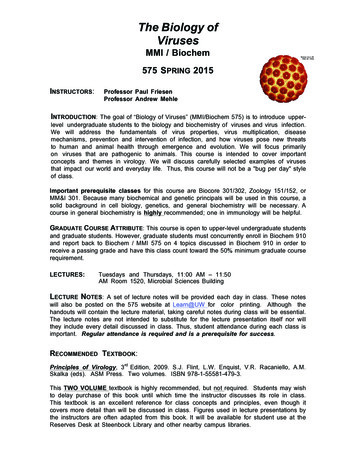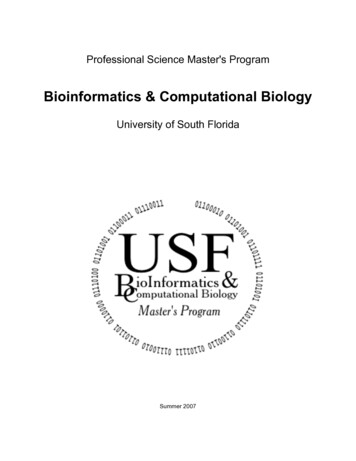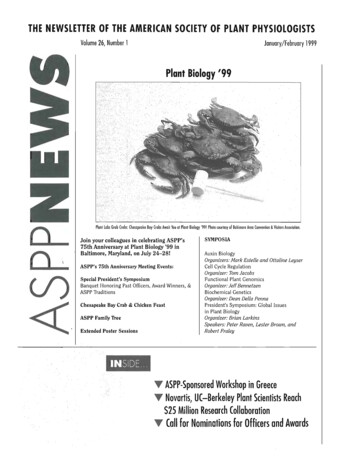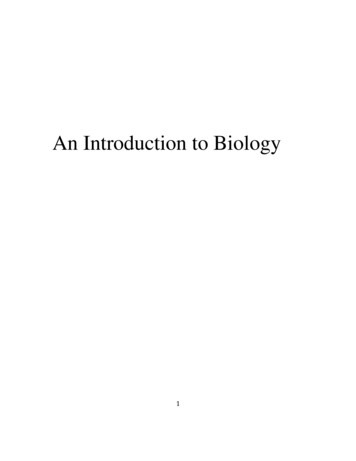
Transcription
CAMPBELLBIOLOGYC O NC E P T S & C ON N E C T ION S MARTHA R. TAYLORNINTHEDITIONJEAN L. DICKEYIthaca, New YorkClemson UniversityERIC J. SIMONKELLY HOGANNew England CollegeUniversity of North Carolina, Chapel HillJANE B. REECEBerkeley, California330 Hudson Street, New York, NY 10013TAYL3402 09 FM NASTA PRF.indd 111/18/16 10:46 PM
Courseware Portfolio Management Director: Beth WilburCourseware Director of Content Development:Ginnie Simione JutsonCourseware Portfolio Management Specialist:Alison RodalDevelopment Editors: Julia Osborne, Susan Teahan,Mary Catherine Hager, Debbie Hardin, Evelyn DahlgrenEditorial Coordinator: Alison CagleDirector of Content Production and Digital Studio:Erin GreggManaging Producer, Science: Michael EarlyContent Producers: Mae Lum, Courtney TowsonProduction Management and Composition: Alverne Ball,Integra Software Services, Inc.Design Manager: Mark OngCover and Interior Designer: Elise LansdonIllustrations: Lachina Publishing Services, IncPhoto Researcher: Kristin PiljaySenior Content Lead MasteringBiology : Sarah JensenRich Media Content Producer: Chloe VeylitSenior Manager Web Development: Steve WrightWeb Development Lead: Jim HuffordVice President of Marketing: Christy LeskoProduct Marketing Manager: Christa PelaezField Marketing Manager: Kelly GalliSenior Manufacturing Buyer: Stacey WeinbergerCover Printer: Phoenix Color/HagerstownText Printer: Courier/KendallvilleCover Photo Credit: Heather Angel/Natural Visions/Alamy Stock PhotoCopyright 2018, 2015, 2012 Pearson Education, Inc. All Rights Reserved. Printed in the United States of America. Thispublication is protected by copyright, and permission should be obtained from the publisher prior to any prohibitedreproduction, storage in a retrieval system, or transmission in any form or by any means, electronic, mechanical,photocopying, recording, or otherwise. For information regarding permissions, request forms and the appropriatecontacts within the Pearson Education Global Rights & Permissions department, please visit www.pearsoned.com/permissions/.Acknowledgements of third party content appear on page A-26, which constitutes an extension of this copyright page oron the appropriate page within the text.PEARSON, ALWAYS LEARNING, MasteringBiology and BioFlix are exclusive trademarks in the U.S. and/or other countriesowned by Pearson Education, Inc. or its affiliates.Unless otherwise indicated herein, any third-party trademarks that may appear in this work are the property of theirrespective owners and any references to third-party trademarks, logos or other trade dress are for demonstrative ordescriptive purposes only. Such references are not intended to imply any sponsorship, endorsement, authorization,or promotion of Pearson’s products by the owners of such marks, or any relationship between the owner and PearsonEducation, Inc. or its affiliates, authors, licensees or distributors.Library of Congress Cataloging-in-Publication DataNames: Reece, Jane B. Taylor, Martha R. Simon, Eric J. (Eric Jeffrey),1967- Dickey, Jean Hogan, Kelly A.Title: Campbell biology : concepts & connections / Jane B. Reece, Berkeley,California, Martha R. Taylor, Ithaca, New York, Eric J. Simon, New EnglandCollege, Jean L. Dickey, Clemson University, Kelly Hogan, University ofNorth Carolina, Chapel Hill.Other titles: BiologyDescription: Ninth edition. Boston : Pearson Education, [2017]Identifiers: LCCN 2016019061Subjects: LCSH: Biology.Classification: LCC QH308.2 .B56448 2017 DDC 570—dc23LC record available at https://lccn.loc.gov/20160190611 16ISBN 10: 0-13-465340-8 (High School Binding)ISBN 13: 978-0-13-465340-2 (High School Binding)www.PearsonSchool.com/AdvancedTAYL3402 09 FM NASTA PRF.indd 211/18/16 10:46 PM
About the AuthorsMartha R. Taylor has been teachingbiology for more than 35 years. Sheearned her B.A. in biology fromGettysburg College and her M.S. andPh.D. in science education from CornellUniversity. At Cornell, Dr. Taylor hasserved as assistant director of the Officeof Instructional Support and has taughtintroductory biology for both majorsand nonmajors. Most recently, she was alecturer in the Learning Strategies Center, teaching supplementalbiology courses. Her experience working with students inclassrooms, in laboratories, and with tutorials has increased hercommitment to helping students create their own knowledge ofand appreciation for biology. She was the author of the StudentStudy Guide for ten editions of Campbell Biology.Eric J. Simon is a professor in theDepartment of Biology and HealthScience at New England College inHenniker, New Hampshire. He teachesintroductory biology to science majorsand nonscience majors, as well asupper-level courses in tropical marinebiology and careers in science. Dr.Simon received a B.A. in biology andcomputer science and an M.A. in biologyfrom Wesleyan University, and a Ph.D. in biochemistry fromHarvard University. His research focuses on innovative ways touse technology to improve teaching and learning in the scienceclassroom. Dr. Simon also leads numerous international studentfield research trips and is a Scientific Advisor to the ElephantConservation Center in Sayaboury, Laos. Dr. Simon is the leadauthor of the introductory nonmajors biology textbooks CampbellEssential Biology, Sixth Edition, and Campbell Essential Biologywith Physiology, Fifth Edition, and the author of the introductorybiology textbook Biology: The Core, Second Edition.Jean L. Dickey is Professor Emeritaof Biological Sciences at ClemsonUniversity (Clemson, South Carolina).After receiving her B.S. in biology fromKent State University, she went on toearn a Ph.D. in ecology and evolutionfrom Purdue University. In 1984, Dr.Dickey joined the faculty at Clemson,where she devoted her career toteaching biology to nonscience majorsin a variety of courses. In addition to creating content-basedinstructional materials, she developed many activities to engagelecture and laboratory students in discussion, critical thinking,and writing, and implemented an investigative laboratorycurriculum in general biology. Dr. Dickey is author of LaboratoryInvestigations for Biology, Second Edition, and coauthor ofCampbell Essential Biology, Sixth Edition, and Campbell EssentialBiology with Physiology, Fifth Edition.Kelly Hogan is a faculty memberin the Department of Biology atthe University of North Carolina atChapel Hill, teaching introductorybiology and genetics. Dr. Hoganteaches hundreds of students at atime, using active-learning methodsthat incorporate educationaltechnologies both inside and outsideof the classroom. She received herB.S. in biology at the College of New Jersey and her Ph.D. inpathology at the University of North Carolina, Chapel Hill.Her research interests focus on how large classes can be moreinclusive through evidence-based teaching methods andtechnology. As the Director of Instructional Innovation atUNC, she encourages experienced faculty to take advantage ofnew professional development opportunities and inspires thenext generation of innovative faculty. Dr. Hogan is the authorof Stem Cells and Cloning, Second Edition, and co-author onCampbell Essential Biology with Physiology, Fifth Edition.Jane B. Reece has worked inbiology publishing since 1978,when she joined the editorialstaff of Benjamin Cummings.Her education includes an A.B. inbiology from Harvard University, anM.S. in microbiology from RutgersUniversity, and a Ph.D. in bacteriologyfrom the University of California,Berkeley. At UC Berkeley, and lateras a postdoctoral fellow in genetics at Stanford University,her research focused on genetic recombination in bacteria.Dr. Reece taught biology at Middlesex County College (NewJersey) and Queensborough Community College (New York).During her 12 years as an editor at Benjamin Cummings, sheplayed a major role in a number of successful textbooks. Sheis coauthor of Campbell Biology, Eleventh Edition, CampbellBiology in Focus, Second Edition, Campbell Essential Biology,Sixth Edition, and Campbell Essential Biology with Physiology,Fifth Edition.Neil A. Campbell (1946–2004)combined the inquiring nature of aresearch scientist with the soul of acaring teacher. Over his 30 years ofteaching introductory biology to bothscience majors and nonscience majors,many thousands of students had theopportunity to learn from him and bestimulated by his enthusiasm for thestudy of life. While he is greatly missedby his many friends in the biology community, his coauthorsremain inspired by his visionary dedication to education and arecommitted to searching for ever better ways to engage studentsin the wonders of biology.About the AuthorsTAYL3402 09 FM NASTA PRF.indd 3iii11/18/16 10:46 PM
See ConnectionsNew Features of the ninth edition of Campbell Biology: Concepts & Connectionsprovide students with a framework for understanding biological concepts andencourage students to see connections between concepts and the world outsideof the classroom.NEW! Unit Openershighlight the relevancyof the course tocareers in a varietyof fields.Connection and EvolutionConnection Modules presentengaging examples and relatechapter content to evolution.NEW! A reframed focus on Major Themesin Biology provide students with a framework forunderstanding and organizing biological concepts.Icons throughout the text call students attention toexamples of specific themes within each chapter.ivTAYL3402 09 FM NASTA PRF.indd 411/18/16 10:46 PM
Build Science Literacy Skills1996Cases documented inevery U.S. state except Alaska2002Major outbreak in Hong Kong;no cases since 2004THSevere acuterespiratory syndromeUALIZIETAWest Nile virusNGAIDS1981To date, 71 million infectedwith HIV; 34 million dead1918Deadliest outbreak ever;20–50 million dead in 18 monthsVISH1N1 fluDANEW! Visualizing the DataFigures are eye-catchinginfographics designed to providestudents with a fresh approachto understanding conceptsillustrated by quantitativeinformation.H1N1 flu2009A combinationof bird, swine,and human virusesAvian fluZika fever2015Transmitted by mosquitoes;spread via sexual contactEbola1976Biggest outbreak from2014 to 2016 in West Africa1997Rarely occursin North AmericaScientific Thinking modulesexplore how scientists use the processof science and discovery. End-ofmodule questions prompt studentsto think critically.A new presentation of theprocess of science in chapter 1demonstrates to students the iterativenature of scientific research.vTAYL3402 09 FM NASTA PRF.indd 511/18/16 10:46 PM
Visualize Tough TopicsEXPANDED!Visualizing theConcept Modulesbring dynamic visualsand text together towalk students throughtough concepts. Theninth edition features28 of these immersivemodules. Select modulesare assignable inMasteringBiologyas animated videos.Embedded textcoaches studentsthrough key pointsand help addresscommonmisunderstandings.viTAYL3402 09 FM NASTA PRF.indd 611/18/16 10:46 PM
and Develop UnderstandingStreamlined textand illustrationsstep studentsthrough theconcept.NEW! Topics in the ninthedition include:1.3: Hierarchy of Life6.9: Oxidative Phosphorylation8.17: Crossing Over13.14: Natural Selection25.4: OsmoregulationviiTAYL3402 09 FM NASTA PRF.indd 711/18/16 10:46 PM
Encourage Focus onMain headings allowstudents to see the bigpicture.A Central Conceptat the start of eachmodule helps students tofocus on one concept ata time.Try This activities in every chapterencourage students to activelyengage with the figures and developpositive study habits.viiiTAYL3402 09 FM NASTA PRF.indd 811/18/16 10:46 PM
Key Concepts and Active LearningCheckpoint questionsat the end of every modulelet students check theirunderstanding right away.Figures describinga process take studentsthrough a series of numberedsteps keyed to explanationsin the text.Chapter summaries includefigures and text to help students reviewand check their understanding of thechapter concepts.ixTAYL3402 09 FM NASTA PRF.indd 911/18/16 10:46 PM
Continuous LearningBefore, During, and After ClassBefore ClassInteractive assignments introduce students to key conceptsNEW! Key Topic Overview videos introduce students to key concepts andvocabulary and are created by authors Eric Simon, Jean Dickey and Kelly Hogan. All12 videos are delivered as a whiteboard style mini-lesson and are accompaniedby assessment so that students can check their understanding.Dynamic Study Modules providestudents with multiple sets of questionswith extensive feedback so that they cantest, learn, and retest until they achievemastery of the textbook material.xTAYL3402 09 FM NASTA PRF.indd 1011/18/16 10:46 PM
with MasteringBiologyCreate pre-lecture assignmentswith 170 author createdinteractive coachingactivities.EXPANDED! Give students extra practicewith 18 assignable Visualizing theConcept videos, which pair with theselect modules in the text.xiTAYL3402 09 FM NASTA PRF.indd 1111/18/16 10:46 PM
Continuous LearningBefore, During, and After ClassDuring ClassEncourage engagement with dynamic videos and resources for in class activitiesNEW! HHMI Short Filmsare documentary-quality movies from theHoward Hughes Medical Institute withexplorations from the discovery of thedouble helix to evolution and includeassignable questions.Chapter 4: A Tour of the CellGuided Reading Activities, in theMasteringBiology study area, accompany allchapters and are designed to help students stayon track and develop active reading skills. Big idea: The nucleus and ribosomesAnswer the following questions as you read modules 4.5–4.6:1.DNA and its associated proteins are referred to as .2.Which of the following cells would be preparing to divide? Briefly explain your answer.AResources to help instructors plandynamic lectures:3. NEW! Ready-to-Go Teaching Modules help instructors efficiently make use of the available teaching tools for the toughest topics. The Instructor Exchange provides active learning techniques from biology instructors aroundthe nation. Co-author Kelly Hogan moderates theexchange.BComplete the following table that compares rRNA to mRNA.rRNAmRNARole in/part of . . .Made in . . .Travels to . . .4.Briefly describe the relationship between the nucleus and ribosomes. Your answer shouldinclude the following key terms: mRNA, rRNA, and protein synthesis.xiiTAYL3402 09 FM NASTA PRF.indd 1211/18/16 10:46 PM
with MasteringBiologyLearning Catalytics is a “bring your owndevice” (laptop, smartphone, or tablet) engagement,assessment, and classroom intelligence system thatallows for active learning and discussion.NEW! Try Thisquestions inLearning Catalyticsare easy to assign in-classactive learning questions,based on the text “TryThis” feature.NEW! EverydayBiology Videosbriefly explore interestingand relevant biology topicsthat relate to conceptsthat students are learningin class. These 20 videos,produced by the BBC,can be assigned inMasteringBiology.xiiiTAYL3402 09 FM NASTA PRF.indd 1311/18/16 10:46 PM
Engage in Biologyanytime, anywhereAFTER CLASSDynamic activities let students put skills into practiceScientific Thinking Activitieshelp students develop an understanding ofhow scientific research is conducted.Examples of topics include: What Is the Role of Peer Review in the Process of Science? How Does “Citizen Science” Affect Scientific Data Collection? Do the Microorganisms in Our Digestive Tract Play a Role in Obesity?Current Events Activities cover a widerange of biological topics to demonstrate tostudents how science connects to everyday life.xivTAYL3402 09 FM NASTA PRF.indd 1411/18/16 10:46 PM
with MasteringBiologyNEW! Evaluating Science inthe Media Activities teach studentsto recognize validity, bias, purpose,and authority in everyday sources ofinformation.NEW! eText 2.0 is now available onsmartphones, tablets and computers, featuringseamlessly integrated videos, and concept checkquestions. The eText 2.0 mobile app is availablefor most iOS and Android phones.Powerful interactive andcustomization functions includeintegrated videos and concept check questions,accessible (screen-reader ready), note-taking,highlighting, bookmarking, search, and linksto glossary terms.xvTAYL3402 09 FM NASTA PRF.indd 1511/18/16 10:46 PM
PrefaceIConnections Students are more motivated to study biologynspired by the thousands of students in our own classesover the years and by enthusiastic feedback from the manyinstructors who have used or reviewed our book, we are delighted to present this new, Ninth Edition. We authors haveworked together closely to ensure that both the book and thesupplementary material online reflect the changing needsof today’s courses and students, as well as current progressin biology. Titled Campbell Biology: Concepts & Connections tohonor Neil Campbell’s founding role and his many contributions to biology education, this book continues to have a dualpurpose: to engage students from a wide variety of majors inthe wonders of the living world and to show them how biology relates to their own existence and the world they inhabit.Most of these students will not become biologists themselves,but their lives will be touched by biology every day. Understanding the concepts of biology and their connections toour lives is more important than ever. Whether we’re concerned with our own health or the health of our planet, afamiliarity with biology is essential. This basic knowledge andan appreciation for how science works have become elementsof good citizenship in an era when informed evaluations ofhealth issues, environmental problems, and applications ofnew technology are critical.when they can connect it to their own lives and interests—forexample, when they are able to relate science to health issues,economic problems, environmental quality, ethical controversies, and social responsibility. In this edition, purple Connectionicons mark the numerous application modules that go beyondthe core biological concepts. For example, the new ConnectionModule 32.6 describes how humans tap into plant transportmechanisms for harvesting such materials as maple syrup andlatex. In addition, our Evolution Connection modules, identified by green icons, connect the content of each chapter to thegrand unifying theme of evolution, without which the study oflife has no coherence. For example, a new Evolution Connectionin Chapter 14 uses data from studies by Rosemary and PeterGrant and their students to demonstrate the continuing effectsof natural selection on Darwin’s finches. Explicit connectionsare also made between the chapter introduction and eitherthe Evolution Connection module or the Scientific Thinkingmodule in each chapter; high-interest questions introduce eachchapter, drawing students into the topic and encouraging acuriosity to explore the question further when it appears againlater in the chapter. And, connections are made in every chapterbetween key concepts and the core concepts of biology.Concepts and ConnectionsNew to This EditionConcepts Biology is a vast subject that gets bigger everyyear, but an introductory biology course is still only oneor two semesters long. This book was the first introductorybiology textbook to use concept modules to help studentsrecognize and focus on the main ideas of each chapter. Theheading of each module is a carefully crafted statement ofa key concept. For example, “Helper T cells stimulate thehumoral and cell-mediated immune responses” announcesa key concept about the role of helper T cells in adaptive immunity (Module 24.12). Such a concept heading serves as afocal point, and the module’s text and illustrations convergeon that concept with explanation and, often, analogies. Themodule text walks the student through the illustrations, justas an instructor might do in class. And in teaching a sequential process, such as the one diagrammed in Figure 24.12A,we number the steps in the text to correspond to numberedsteps in the figure. The synergy between a module’s narrativeand graphic components transforms the concept headinginto an idea with meaning to the student. The checkpointquestion at the end of each module encourages students totest their understanding as they proceed through a chapter.Finally, in the Chapter Review, all the key concept statements are listed and briefly summarized under the overarching section titles, explicitly reminding students of whatthey’ve learned.New Focus on Five Underlying Themes of BiologyxviA major goal of this Ninth Edition is to provide students withan explicit framework for understanding and organizing thebroad expanse of biological information presented in Conceptsand Connections. This framework is based on the five majorthemes outlined in Vision and Change in Undergraduate BiologyEducation: A Call to Action published by the American Academyfor the Advancement of Science. These major themes extendacross all areas of biology: evolution, the flow of information,the correlation of structure and function, the exchange ofenergy and matter, and the interactions and interconnectionsof biological systems. Chapter 1 introduces each of these themesin a separate module. Specific examples of the themes arethen called out in each chapter by green icons: INFORMATION ,STRUCTURE AND FUNCTION , ENERGY AND MATTER ,INTERACTIONS , andEVOLUTIONCONNECTION(always in module form).Expanded Coverage of the Process of ScienceChapter 1 also includes an enhanced focus on the natureof science and the process of scientific inquiry, setting thestage for both the content of the text and the process bywhich our biological knowledge has been built and continues to grow. We continue this emphasis on the process ofscientific inquiry through our Scientific Thinking modulesPrefaceTAYL3402 09 FM NASTA PRF.indd 1611/18/16 10:46 PM
in every chapter, which are called out with an orange icon.New concept check questions for these modules focus onaspects of the process of science: the forming and testing ofhypotheses; experimental design; variables and controls;the analysis of data; and the evaluation and communicationof scientific results.of many figures make the book even more appealing and accessible to visual learners. Much of the art in Chapter 6, How CellsHarvest Chemical Energy, for example, has been revised to helpstudents work through the complex reactions of cellular respiration. Other examples of improved art are found in Figures5.15B, 10.11A, and 37.22B.Additional Visualizing the Concept Modules TheseThe Latest Science Biology is a dynamic field of study,and we take pride in our book’s currency and scientific accuracy. For this edition, as in previous editions, we have integrated the results of the latest scientific research throughoutthe book. We have done this carefully and thoughtfully,recognizing that research advances can lead to new ways oflooking at biological topics; such changes in perspective cannecessitate organizational changes in our textbook to betterreflect the current state of a field. For example, Chapter 12uses both text and art to present the innovative CRISPRCas9 system for gene editing. You will find a unit-by-unitaccount of new content and organizational improvementsin the “New Content” section on pages xix–xx followingthis Preface.modules, which were new to the Eighth Edition, have raisedour hallmark art–text integration to a new level. Visualizingthe Concept modules take challenging concepts or processesand walk students through them in a highly visual manner,using engaging, attractive art; clear and concise labels; andinstructor “hints” called out in light blue bubbles. Theseshort hints emulate the one-on-one coaching an instructormight provide to a student during office hours and helpstudents make key connections within the figure. Examplesof the eight new Visualizing the Concept modules includeModule 6.9, Most ATP production occurs by oxidative phosphorylation; Module 8.17, Crossing over further increasesgenetic variability; Module 13.14, Natural selection canalter variation in a population in three ways; Module 28.6,Neurons communicate at synapses, and Module 34.18, Theglobal water cycle connects aquatic and terrestrial biomes.New Visualizing the Data Figures Also new to thisVISNGTHTAedition are figures that present data in an infographicform, marked by Visualizing the Data icons.UALIZIThese 19 eye-catching figures provide studentsE DAwith a fresh approach to understanding theconcepts illustrated by graphs and numerical data. Figure 10.19maps emergent virus outbreaks, showing that they originatethroughout the world. Figure 12.17 summarizes a wealth ofbioinformatics data on genome sizes versus the number ofgenes found in various species. Figure 13.16 illustrates thegrowing threat of antibiotic resistant bacteria. Figure 21.14allows students to directly compare caloric intake (via food)with caloric expenditure (via exercise). Figure 30.5B showschanges in bone mass during the human life span. Figure 36.11offers an illuminating visual comparison of the per capita andnational ecological footprints of several countries with worldaverage and “fair share” footprints. Figure 38.3 shows graphicevidence of global warming by tracking annual global temperatures since 1880.New Unit Openers That Feature Careers Related tothe Content of the Unit Expanding our emphasis on theconnections of biology to students’ lives, each unit opener pagenow includes photos of individuals whose professions relate tothe content of the unit. For instance, Unit I features a breweryowner and a solar energy engineer. Unit IV portrays a hatchery manager and a paleoanthropologist. These examples areintended to help students see how their biology course relates tothe world outside the classroom and to their own career paths.New Design and Improved Art The fresh new design usedthroughout the chapters and the extensive reconceptualizationMasteringBiology MasteringBiology, the most widelyused online tutorial and assessment program for biology, continues to accompany Campbell Biology: Concepts & Connections.In addition to 170 author-created activities that help studentslearn vocabulary, extend the book’s emphasis on visual learning, demonstrate the connections among key concepts (helping students grasp the big ideas), and coach students on howto interpret data, the Ninth Edition features new assignablevideos. These videos bring this text’s Visualizing the Conceptmodules to life, help students learn how to evaluate sources ofscientific information for reliability, and include short newsvideos that engage students in the many ways course conceptsconnect to the world outside the classroom. MasteringBiology for Campbell Biology: Concepts & Connections, NinthEdition, will help students to see strong connections throughtheir text, and the additional practice available online allowsinstructors to capture powerful data on student performance,thereby making the most of class time.Upon textbook purchase, students and teachers are grantedaccess to MasteringBiology with Pearson eText. High schoolteachers can obtain preview or adoption access to MasteringBiology in one of the following ways:Preview Access Teachers can request preview access online by visitingwww.PearsonSchool.com/Access Request. Select Science,choose Initial Access, and complete the form underOption 2. Preview Access information will be sent to theteacher via e-mail.Adoption Access With the purchase of this program, a Pearson AdoptionAccess Card with Instructor Manual will be delivered withyour textbook purchase. (ISBN: 978-0-13-354087-1)PrefaceTAYL3402 09 FM NASTA PRF.indd 17xvii11/18/16 10:46 PM
Ask your sales representative for a Pearson Adoption AccessCard with Instructor Manual. (ISBN: 978-0-13-354087-1)OR Visit PearsonSchool.com/Access Request, select Science,choose Initial Access, and complete the form underOption 3—MyLab/Mastering Class Adoption Access.Teacher and Student access information will be sent tothe teacher via e-mail.Students, ask your teacher for accessPearson reserves the right to change and/or update technology platforms, including possible edition updates to customers during theterm of access. This will allow Pearson to continue to deliver the mostup-to-date content and technology to customers. Customer will benotified of any change prior to the beginning of the new school year.This Book’s FlexibilityAlthough a biology textbook’s table of contents is by designlinear, biology itself is more like a web of related conceptswithout a single starting point or prescribed path. Courses cannavigate this network by starting with molecules, with ecology, or somewhere in-between, and courses can omit topics.Campbell Biology: Concepts & Connections is uniquely suited tooffer flexibility and thus serve a variety of courses. The sevenunits of the book are largely self-contained, and in a number ofthe units, chapters can be assigned in a different order withoutmuch loss of coherence. The use of numbered modules makesit easy to skip topics or reorder the presentation of material.For many students, introductory biology is the onlyscience course that they will take during their collegeyears. Long after today’s students have forgotten most ofthe specific content of their biology course, they will beleft with general impressions and attitudes about scienceand scientists. We hope that this new edition of Campbell Biology: Concepts & Connections helps make those impressions positive and supports instructors’ goals for sharingthe fun of biology. In our continuing efforts to improve thebook and its supporting materials, we benefit tremendouslyfrom instructor and student feedback, not only in formalreviews but also via informal communication. Please let usknow how we are doing and how we can improve the nextedition of the book.Martha Taylor(Chapter 1 and Unit I),mrt2@cornell.eduEric Simon(Units II and VI and Chapters 21 and 27),SimonBiology@gmail.comJean Dickey(Units III, IV, and VII and Chapters 22 and 30),dickeyj@clemson.eduKe
Essential Biology, Sixth Edition, and Campbell Essential Biology with Physiology, Fifth Edition, and the author of the introductory biology textbook Biology: The Core, Second Edition. Jean L. Dickey is Professor Emerita of Biological Sciences at Clemson University (Clemson, South Carolina).

